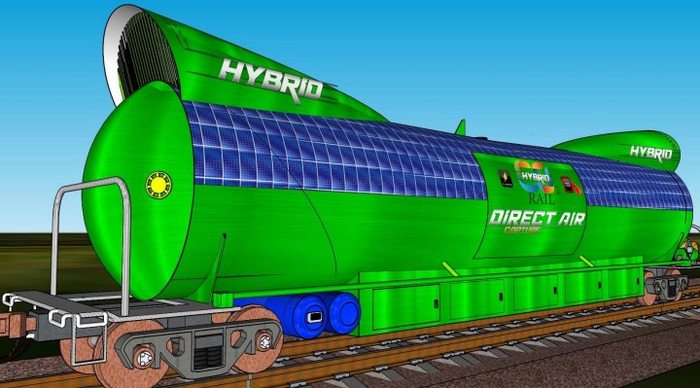
Train car for direct air capture. Image Credit: Joule/Bachman et al.
In an article published on July 20th, 2022, in the peer-reviewed journal Joule, a research team underlines a strategy to retrofit train cars to eliminate carbon from the air at a much lower than average cost per ton to design a direct air capture process that uses less energy and less land.
Stationary direct air capture facilities necessitate large tracts of land to house their equipment and build the renewable energy sources that power them. It can be hard to obtain the necessary permits that would allow them to operate, and many residents are opposed to the construction of these major facilities in their towns and cities.
"It’s a huge problem because most everybody wants to fix the climate crisis, but nobody wants to do it in their backyard. Rail-based direct air capture cars would not require zoning or building permits and would be transient and generally unseen by the public."
Geoffrey Ozin, Study Co-Author and Carbon Dioxide Utilization Chemist, University of Toronto
Ozin was also a chemical engineer and director of the solar fuels group.
These purpose-built train cars absorb air through large vents, eliminating the need for the energy-intensive fan systems used by stationary direct air capture systems.
After capturing a sufficient amount of carbon dioxide, the chamber is closed, and the harvested carbon dioxide is gathered, concentrated, and deposited in a liquid reservoir until it can be drained from the train at crew change or fueling halts for direct transportation into the circular carbon economy or to adjacent geological sequestration locations.
The carbon-dioxide-free air then exits the car through the back or underside and goes back to the atmosphere.
When a train’s brakes are applied, the energy braking system transforms forward momentum into electric power. When the braking system is applied, the energy is released as heat and discharged through the top.
"That is wasted energy. Every complete braking maneuver generates enough energy to power 20 average homes for a day, so we’re not talking about a trivial amount of energy."
E. Bachman, Study Lead Author, Founder, Co2Rail
The authors propose that this energy be used to help deal with climate change.
Since the rail system is in place, the authors suggest that direct air capture becomes an even more sustainable climate solution.
“The infrastructure exists,” says Ozin. “That’s the bottom line. All you need to do is take advantage of what is already available.”
According to scientists, an average freight train equipped with these direct air capture cars could save up to 6,000 tons of CO2 per year. The price per ton is substantially lower than those of other direct air capture systems since its sustainable energy needs are met by onboard inputs.
“The projected cost at scale is less than $50 per ton, which makes the technology not only commercially feasible but commercially attractive,” Bachman says.
The researchers asserted that this technology would have a positive effect in addition to removing carbon from the atmosphere.
“We could get a positive-feedback loop where the encouragement of rail to broadly deploy these direct air capture rail cars could even further decrease carbon emissions because rail is about five or six times more efficient than trucks,” says Bachman. “By increasing rail utilization, you increase the efficiency of the entire transportation system.”